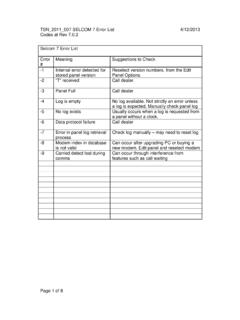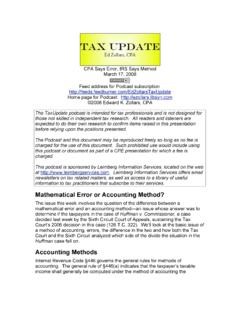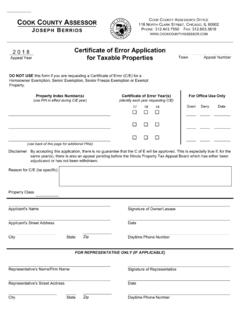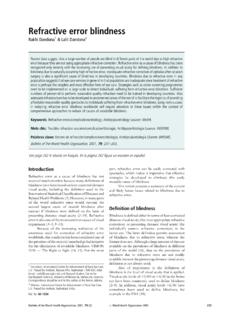Transcription of Case parameter estimator standard error Estimate …
1 STA 2023 Practice Questions Exam 2 Chapter 7- sec Formulas Given on the test: Memorize these Formulas: General Format for Confidence Interval: estimator +/- (t or z) est. standard error General Format of Test Statistic: #()oestimatorfrom Ht orzestimate ofstderr Determining sample size for estimating proportions and means. Practice Problems on next page. case parameter estimator standard error Estimate of standard error Sampling Distribution one mean x n ns t (n-1) one prop. p p npp)1( CI: (1)ppn ST:npp)1(00 z 1. You take a random sample from some population and form a 96% confidence interval for the population mean, Which quantity is guaranteed to be in the interval you form? a) 0 b) c) x d) .96 2. Suppose you conduct a significance test for the population proportion and your p-value is Given a level of significance, which of the following should be your conclusion?
2 A) accept HO b) accept HA c) Fail to reject HA d) Fail to reject HO e) Reject Ho 3. Decreasing the sample size, while holding the confidence level the same, will do what to the length of your confidence interval? a) make it bigger b) make it smaller c) it will stay the same d) cannot be determined from the given information 4. Decreasing the confidence level, while holding the sample size the same, will do what to the length of your confidence interval? a) make it bigger b) make it smaller c) it will stay the same d) cannot be determined from the given information 5. If you increase the sample size and confidence level at the same time, what will happen to the length of your confidence interval? a) make it bigger b) make it smaller c) it will stay the same d) cannot be determined from the given information 6. Which of the following is a property of the Sampling Distribution of x?
3 A) if you increase your sample size, x will always get closer to the population mean. b) the standard deviation of the sample mean is the same as the standard deviation from the original population c) the mean of the sampling distribution of x is the population mean. d) x always has a Normal distribution. 7. Which of the following is true about p-values? a) a p-value must be between 0 and 1. b) if a p-value is greater than .01 you will never reject HO. c) p-values have a N(0,1) distribution d) None of the above are true. 8. Suppose that we wanted to Estimate the true average number of eggs a queen bee lays with 95% confidence. The margin of error we are willing to accept is Suppose we also know that s is about What sample size should we use? a) 1536 b) 1537 c) 2653 d) 2650 9. What should be the value of z used in a 93% confidence interval?
4 A) b) c) d) 10. What are the possible values of x-bar for all samples of a given n from this population? To answer this question, we would need to look at the: a) test statistic b) z-scores of several statistics c) standard normal distribution d) sampling distribution e) probability distribution of x 11. Why do we use inferential statistics? a) to help explain the outcomes of random phenomena b) to make informed predictions about parameters we don t know c) to describe samples that are normal and large enough (n>30) d) to generate samples of random data for a more reliable analysis 12. A 95% confidence interval for the mean number of televisions per American household is ( , ). For each of the following statements about the above confidence interval, choose true or false. a) The probability that is between and is.
5 95. b) We are 95% confident that the true mean number of televisions per American household is between and c) 95% of all samples should have x-bars between and d) 95% of all American households have between and televisions. e) Of 100 intervals calculated the same way (95%), we expect 95 of them to capture the population mean. f) Of 100 intervals calculated the same way (95%), we expect 100 of them to capture the sample mean. 13. When doing a significance test, a student gets a p-value of This means that: I. Assuming Ho were true, this sample s results were an unlikely event. II. of samples should give results which fall in this interval. III. We reject Ho at any reasonable alpha level. a) II only b) III only c) I and III d) I, II, and III 14. parameters and a) Are both used to make inferences about x b) Describe the population and the sample, respectively.
6 C) Describe the sample and the population, respectively. d) Describe the same group of individuals. 15. A waiter believes that his tips from various customers have a slightly right skewed distribution with a mean of 10 dollars and a standard deviation of dollars. What is the probability that the average of 35 customers will be more than 13 dollars? a) almost 1 b) almost zero c) d) Questions 16-19 A certain brand of jelly beans are made so that each package contains about the same number of beans. The filling procedure is not perfect, however. The packages are filled with an average of 375 jelly beans, but the number going into each bag is normally distributed with a standard deviation of 8. Yesterday, Jane went to the store and purchased four of these packages in preparation for a Spring party. Jane was curious, and she counted the number of jelly beans in these packages - her four bags contained an average of 382 jelly beans.
7 16. In the above scenario, which of the following is a parameter ? a) The average number of jelly beans in Jane s packages, which is 382. b) The average number of jelly beans in Jane s packages, which is unknown. c) The average number of jelly beans in all packages made, which is 375. d) The average number of jelly beans in all packages made, which is unknown. 17. If you went to the store and purchased six bags of this brand of jelly beans, what is the probability that the average number of jelly beans in your bags is less than 373? a) .2709 b) .3085 c) .4013 d) .7291 18. Why can we use the Z table to compute the probability in the previous question? a) because np>15 and n(1-p) > 15 b) because n is large in this problem c) because the distribution of jelly beans is Normal d) because the average is large 19. According to the central limit theorem, what is the standard deviation of the sampling distribution of the sample mean?
8 A) The standard deviation of the population b) The standard deviation of the sample c) The standard deviation of the population divided by the square root of the sample size d) The standard deviation of the sample divided by the square root of the sample size Questions 20-23 Researchers are concerned about the impact of students working while they are enrolled in classes, and they d like to know if students work too much and therefore are spending less time on their classes than they should be. First, the researchers need to find out, on average, how many hours a week students are working. They know from previous studies that the standard deviation of this variable is about 5 hours. 20. A survey of 200 students provides a sample mean of hours worked. What is a 95% confidence interval based on this sample? a) ( , ) b) ( , ) c) ( , ) d) ( , ) 21.
9 Suppose that this confidence interval was ( , ). Which of these is a valid interpretation of this confidence interval? a) There is a 95% probability that the true average number of hours worked by all UF students is between and hours. b) There is a 95% probability that a randomly selected student worked between and hours. c) We are 95% confident that the average number of hours worked by students in our sample is between and hours. d) We are 95% confident that the average number of hours worked by all UF students is between and hours. 22. We have 95% confidence in our interval, instead of 100%, because we need to account for the fact that: a) the sample may not be truly random. b) we have a sample, and not the whole population. c) the distribution of hours worked may be skewed d) all of the above 23. The researchers are not satisfied with their confidence interval and want to do another study to find a shorter confidence interval.
10 What should they change to ensure they find a shorter confidence interval? a) They should increase their confidence level and increase their sample size. b) They should increase their confidence level but decrease their sample size. c) They should decrease their confidence level but increase their sample size. d) They should decrease their confidence level and decrease their sample size. 24. Suppose our p-value is .044. What will our conclusion be at alpha levels of .10, .05, and .01? a) We will reject Ho at alpha=.10, but not at alpha=.05 b) We will reject Ho at alpha=.10 or .05, but not at alpha=.01 c) We will reject Ho at alpha=.10, .05, or .01 d) We will not reject Ho at alpha=.10, .05, or .01 25. For each of the following situations, can we use the Z table to compute probabilities (T/F): _____ a. Weights of adults are approximately Normally distributed with mean 150 lbs and stdev 25 lbs.













